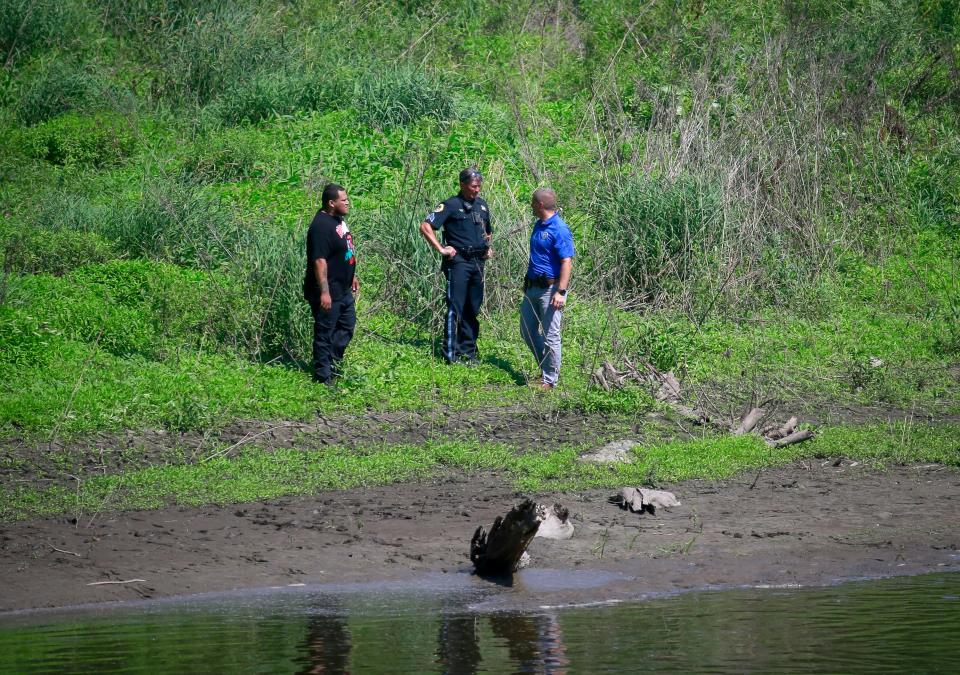Search continued Thursday for body of 11-year-old girl presumed drowned in Raccoon River in Des Moines
An 11-year-old girl who went missing while swimming in the Raccoon River is presumed to have drowned, Des Moines police said Thursday on Twitter.
Police continued to search for her body Thursday.
According to a news release from police spokesperson Sgt. Paul Parizek, patrol officers and Des Moines Fire Department rescue personnel received a report shortly before 6 p.m. Wednesday about the missing child in a section of the river north of the 6000 block of Creston Ave.
"First responders learned that the child, an 11-year-old female, had been on the water on an inflatable raft with two other children," Parizek said in the news release. "The 11-year-old got off the raft, went under the water, and did not resurface."
More: How to keep your children safe while swimming this summer
Joined by the Des Moines police dive team, the fire department 's Water Emergency Team searched the river and it banks.
More: Drowning tragedies can happen to anyone. Here's what parents need to know

Drowning hazards: What to know
Know what to watch for. Remember that drowning doesn't always look like drowning. "What we see portrayed on TV or the movies is kicking and screaming, but usually a drowning incident is silent," says Sue Mackie, who retired as executive director of the U.S. Swim School Association in 2017. "Suddenly they're in a position when they can't get a breath of air and they're going under and it's too late for the fight."
Call for help. Yell to alert a lifeguard or any others around you that a drowning is occurring before you try to save the victim. In case something goes wrong, other people need to know you may need assistance.
Throw, don't go. A young child struggling in the water can easily cause an adult attempting a rescue to drown as well. It is safer to throw a lifesaving device, towel, rope, pool noodle or long stick to the person in the water, wait until he or she grabs it and then use it to tow the person to safety.
Approach from behind. If you need to enter the water to save someone from drowning, it's best to approach the person from behind to lessen the likelihood of being grabbed and pulled under the water as well.
Wear a life jacket. If you are attempting to rescue a drowning victim in open water, put on a U.S. Coast Guard-approved lifejacket, and if possible, secure yourself to a boat or the shore with a rope before entering the water. The lifejacket could save your life and the victim's.
Watch for secondary drowning. People who come close to drowning can still have water in their lungs hours after and need to be watched closely for signs of trouble breathing.
Swimming safety tips
To keep kids safe in the water, the U.S. Swim School Association has developed these guidelines.
Teach your child to swim. Children should take swimming lessons as early as possible; Mackie recommends year-round lessons to keep your kids' skills sharp.
Watch your kids. Even when lifeguards are present, don't assume your child is safe, especially young children who aren't yet strong swimmers. And if you send your child swimming with another adult, make sure that person is a strong swimmer who understands water safety precautions, especially if lifeguards aren't present. Also ensure your children know they're not allowed to swim without adult supervision.
Wear a life jacket. Children who aren't strong swimmers should wear a U.S. Coast Guard-approved personal flotation device. "Don't just count on a pool noodle, water wings or a toy floatie," Mackie said. "They can get away from you too easily." Children should also wear Coast Guard-approved life jackets on boats and personal watercraft like Jet Skis.
Swim with a buddy. "Everyone should swim with a buddy in a supervised area," Mackie said. "This is especially important for teens and tweens who have more freedom. Even if they know how to swim, they shouldn't be swimming alone and should make sure they always have a buddy."
Institute timeouts. Every hour, take five minutes to rest and get a drink. If you're with a large group, that gives you a chance to do a head count, too. Be aware of your children's limitations; if they start to look fatigued, have them get out and rest for a while.
Learn CPR. Learning CPR is especially important if you have a pool or swim frequently without lifeguard supervision.
Install safety equipment. If you have a pool, make sure it has childproof fences and barriers.
Grace Altenhofen is a news reporter for the Des Moines Register. She can be reached at galtenhofen@registermedia.com or on Twitter @gracealtenhofen.
This article originally appeared on Des Moines Register: Child apparently drowns while swimming in Raccoon River in Des Moines

